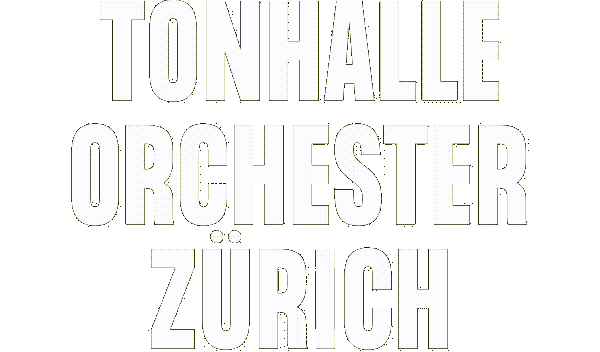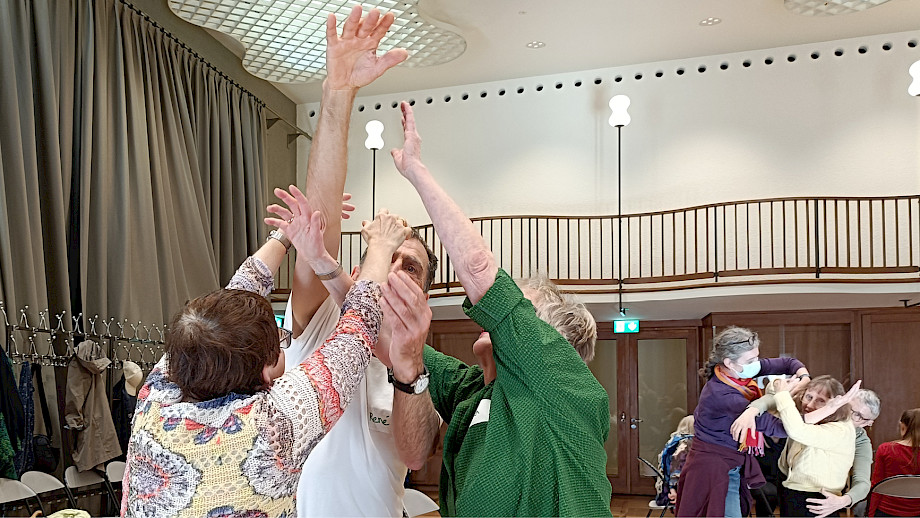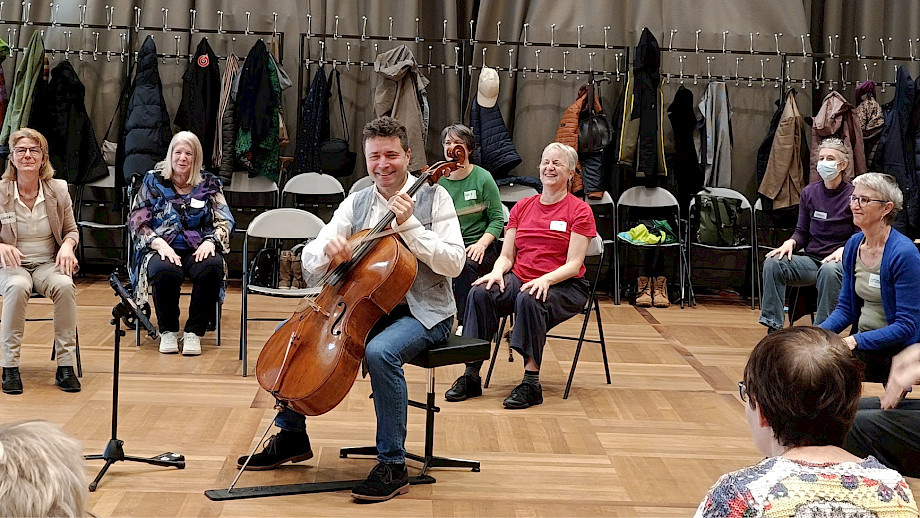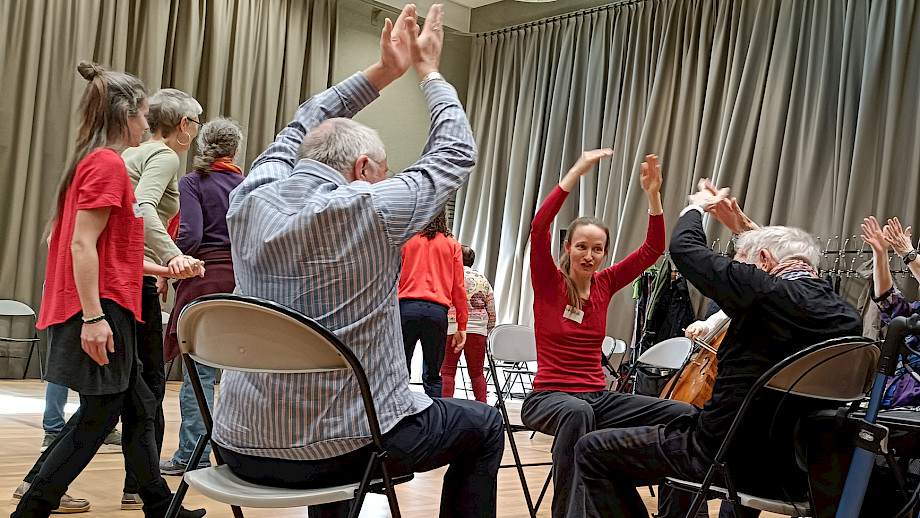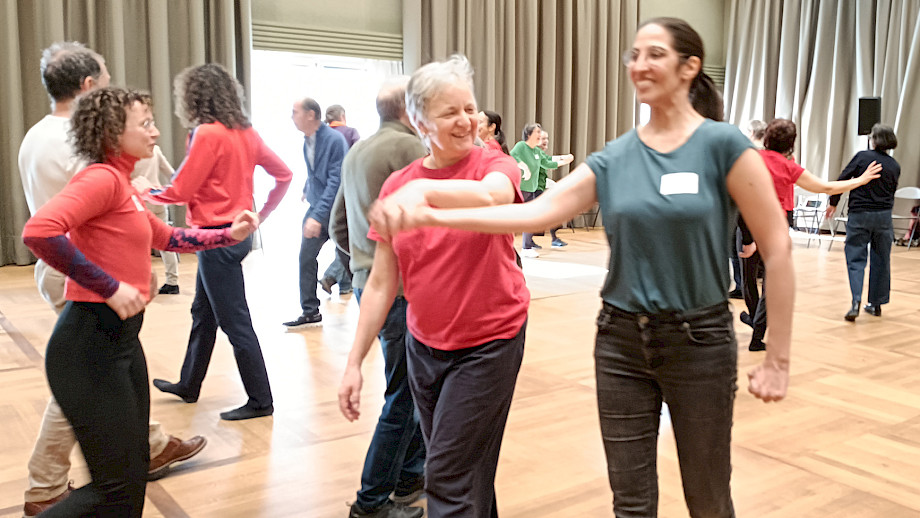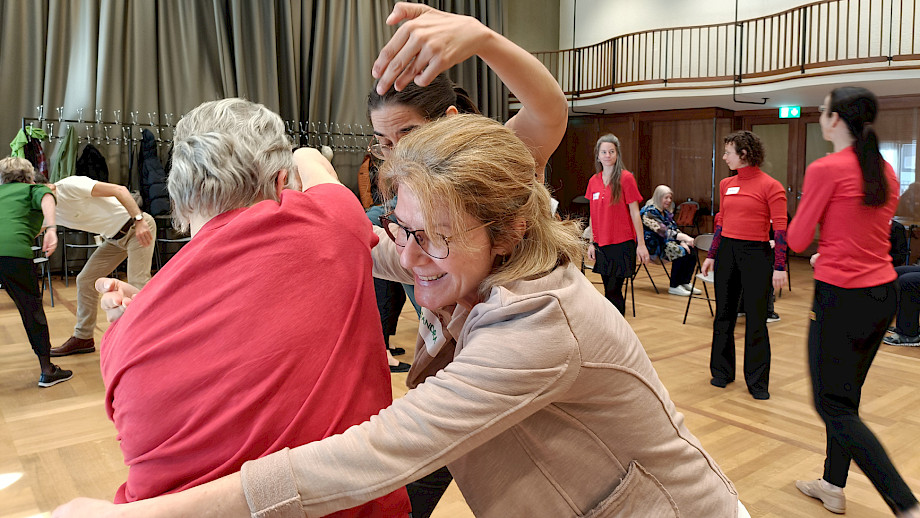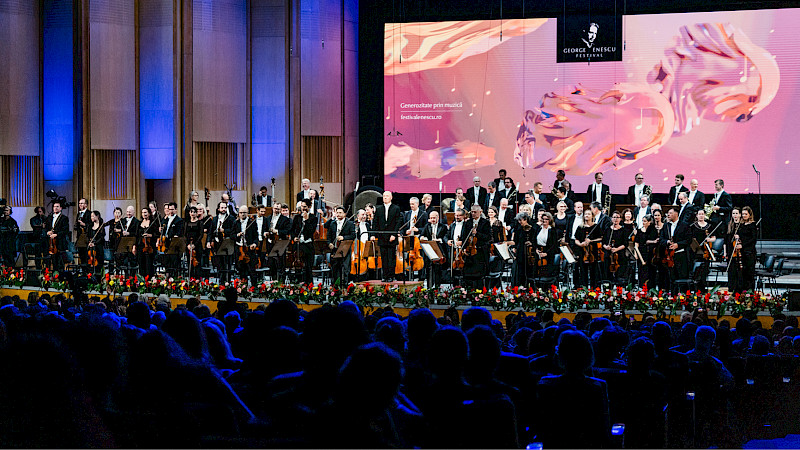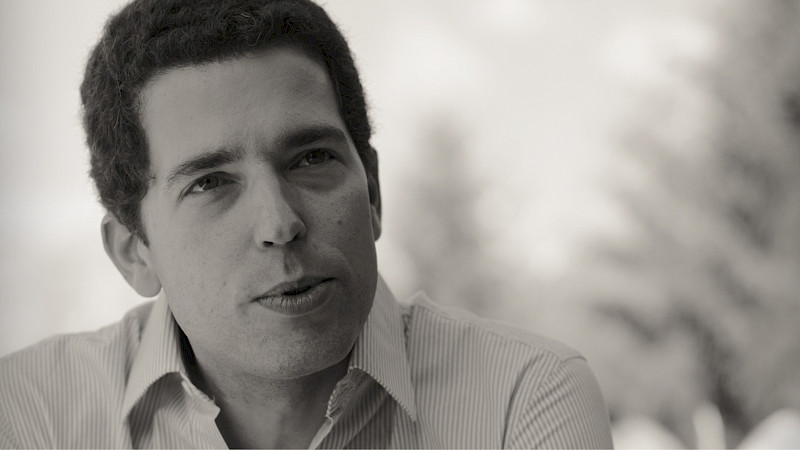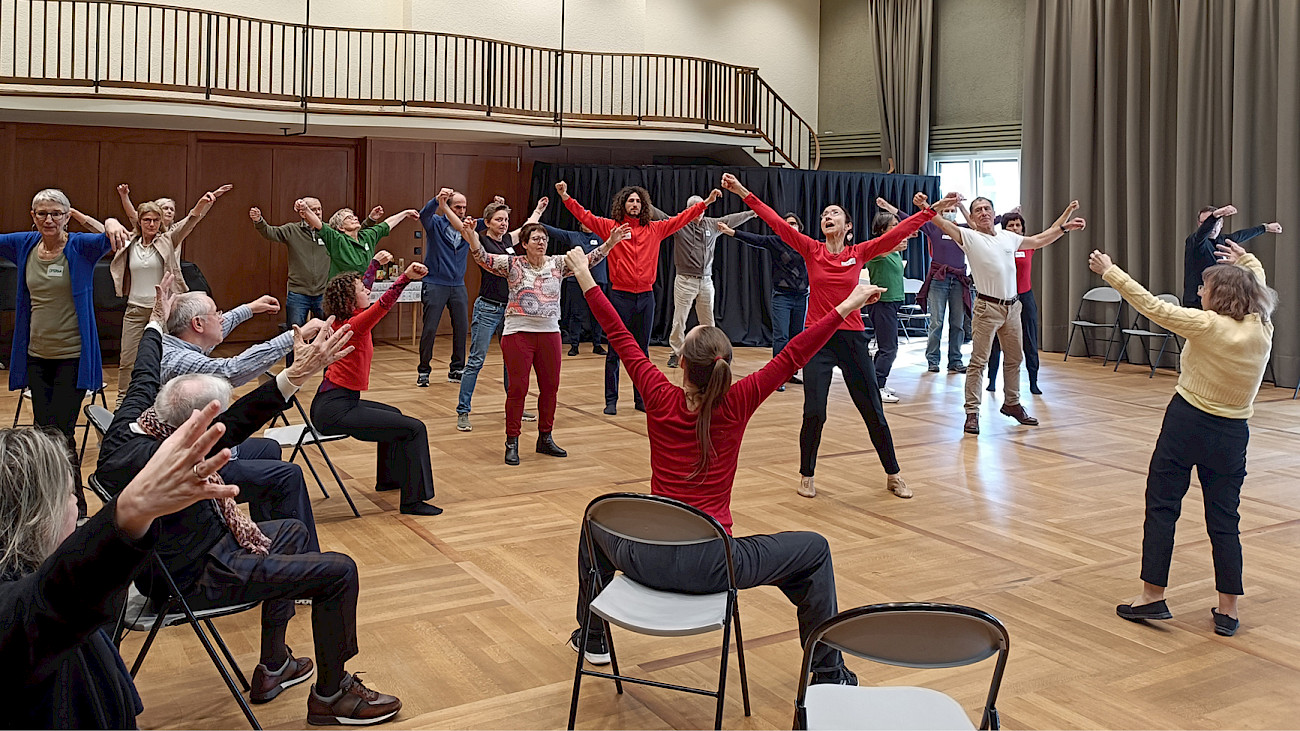
"Where are your stars?"
Last season, dance training sessions for people living with Parkinson's or multiple sclerosis were held for the first time in the Vereinssaal of the Tonhalle Zurich. We danced along.
Friday afternoon, 2.30 pm. Around thirty women and men of all ages sit in a circle in the Vereinssaal and build a universe. Dance trainer Clare Guss-West demonstrates how it's done: with pointed fingers, she places imaginary stars around them, one goes up there, another far to the left, and when she places one under the chair, everyone laughs.
We are at "Connect", a project that was advertised last autumn as "dance training for people with neurological challenges". These "challenges" are specifically Parkinson's or multiple sclerosis, but in the training it doesn't matter who lives with which illness. It also doesn't matter whether you are free-handed, using walking sticks or a rollator, or whether you are a participant or a helper. The only thing that counts is the first name that everyone has stuck on their T-shirt or shirt.
To stay with the image of this afternoon, it is a universe of its own that comes together here. The big bang took place at Zurich Opera House, where ballet director Cathy Marston's choreography "The Cellist" told the story of cellist Jacqueline du Pré, who died of multiple sclerosis at the age of just 42. Cathy Marston knows the disease from close quarters, her mother has MS. And so she looked for allies to extend art into the everyday lives of those affected.
The Tonhalle-Orchester Zuüich joined in, as did the independent performance group The Field and the Dance & Creative Wellness Foundation of former dancer Clare Guss-West. The Parkinson's Society and the Swiss MS Society were enthusiastic, and the Department of Neurology at Zurich University Hospital was interested. Because the approach is new: for the first time, people with different diagnoses are coming together for such a dance training programme. This broadens the age spectrum, because Parkinson's usually occurs later than MS; and the focus is not so much on the progression of a specific disease. "We want to promote the creativity of individuals, regardless of their diagnosis," says Clare Guss-West.
When the project was put out to tender, demand was far greater than expected: in addition to the 60 people from the immediate and wider Zurich area who took part in two groups during the pilot phase, a further 85 are on the waiting list. Media interest is also high, with TV cameras, radio microphones and notepads repeatedly accompanying the training sessions.
Throwing energy
Back to the Vereinssaal. We are still sitting on our chairs, but now we need good balance, because in addition to our arms, we are also stretching our legs in all directions - our universe is growing. And it sounds: because in the centre of the circle sits Diego Baroni, bass clarinettist in the Tonhalle-Orchester Zürich. Sometimes he plays Bach, most of the time he improvises, translating Clare Guss-West's gestures and stories into sounds. Flowing movements sound different from jagged ones, and when one half of the dancers throws the concentrated energy of the universe at the other, the bass clarinet also reaches out far and wide.
The fact that most of the eleven training sessions in the pilot phase took place with live music is one of the special features of "Connect". Cellist Mattia Zappa sat in the centre in front of Diego Baroni, and the participants rave about both of them. He really felt the instruments inside him, says one, "I've never heard them played up close before". Another adds that she is "carried" by the sounds, "they give me a kind of stability and security". For the musicians, this project is also a special experience, "a magical, touching moment", as Mattia Zappa says. Diego Baroni also looked forward to these Friday afternoons; as an experienced jazz musician, he is used to improvising, "but it was always surprising to see what developed". The live music goes a long way towards putting these dance training sessions where they belong: They are not therapy sessions, the participants should not feel like patients. "They are dancers, nothing more and nothing less," says Clare Guss-West.
Respect and warmth
But of course it's no coincidence that this project involves dancing of all things. After all, it has long been scientifically proven how much dancing can do for diseases such as Parkinson's and MS - even more than other sports. Motor processes that falter in everyday life can become more fluid again thanks to the prescribed rhythm. Dancing can also improve mobility, coordination and balance. Various medical experts believe that it can even slow down the development of symptoms. This is all the more important for diseases for which there is still no cure.
"Everyone here treats each other with a great deal of respect and warmth, both the participants and the leaders."
"Connect" participants also talk about regaining their lightness, improving their posture and how confident and courageous they feel after such training. One dancer ventured out of the house without a walking stick for the first time in years. Above all, however, in conversations on the sidelines of the event or during the coffee break, one hears again and again that people "don't feel sick" here. "You can be free, because it doesn't matter what you can still do or what you can no longer do," says one dancer. "Everyone here treats each other with a lot of respect and warmth, both the participants and the leaders."
The fact that the two groups attended rehearsals together in addition to the actual "Connect" training sessions also contributed to the cohesion within the two groups: for the ballet "The Cellist" at the opera house and the multimedia concert "Electric Fields" at the Tonhalle. The dance project is also an invitation to do things together with others, enjoy culture and forget your own limitations for a moment.
Polonaises in space
In the training sessions, these restrictions are recognised - nothing more. You notice it after the coffee break: most of the chairs have now been cleared away and those who can are now spread around the room. The others are sitting close to Diego Baroni, as stable atoms in this universe, so to speak, in which the elements are now setting themselves in motion.
Four dancers hold hands, Clare Guss-West shows the steps: first to the right, in light, upright movements, "and please only fast enough for everyone to follow". The groups move back and forth across the room, like little polonaises, until the music stops. Then they switch to the left and the person at the other end of the chain leads the way. Or they might decide to join the next group, "because it's difficult to do it hands-free". "Nuclear fusion", comments Clare Guss-West, and again there is laughter.
The fact that she sticks to her story so consistently is part of the trainer's concept, "it's called 'external focus of attention'". This time, this focus is on the universe; on other afternoons, the dancers have picked imaginary dandelions or taken off non-existent jumpers. Such stories and visualisations help to learn movements that gradually become more challenging as the training progresses: "When the dancers focus their attention on what is being created here in the imagination, the quality of movement improves, it influences the breath and awakens the senses." And it enables a closeness that we are not used to in everyday life: holding hands, building body sculptures together - it comes naturally when the story demands it.
What happens next?
At the end, we sit down again. "Where are your stars?" asks Clare Guss-West, "we have to collect them again now". We stretch out once again, pluck these stars from the sky and store them in our own bodies. There they will remind us of this universe in our everyday lives - and perhaps help us overcome one or two hurdles.
For this to succeed, for such dance training to have an effect, it needs continuity; research has also shown this. The participants were therefore given videos for the summer break so that they can continue dancing at home. And from October, "Connect" will be continued with a new focus, new movements and new musicians. Several members of the Tonhalle-Orchester Zürich have already announced that they would like to get involved in the continuation of the project.
And the "Connect" universe will continue to grow: a third group will be added in the new season, so that 90 people will be able to take part in future. The project will also be scientifically monitored by neurologists from the University Hospital Zurich. Preparations for a study are underway.
